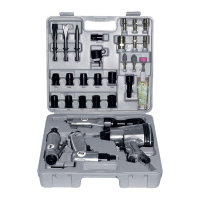9T–10 IMMOBILIZER ANTI-THEFT SYSTEM
DAEWOO M–150 BL2
DESCRIPTION AND OPERATION
IMMOBILIZER SYSTEM
The purpose of the Immobilizer system is to provide
additional theft deterrence to the vehicle in which it is
installed and to prevent it from being stolen or driven by
unauthorized users.
The verification of the user authorization is done by an
ignition key with integrated transponder.
The external LED displays the Immobilizer status and
has an additional theft deterrence function.
To secure the communication, the status is exchanged
between the Immobilizer and the ECM in a 5 byte of en-
coded data.
These 5 bytes are composed by a mixture of random
data and two types of fixed code
D a vehicle model identification number : MIN
D a vehicle specific identification : VIN
The MIN is known from the first supply of the system.
The VIN is realized by ICU on the special order from the
key coding (reading of transponder code and storing it
as valid key code in Immobilizer EEPROM).
A different random data is computed at each key transi-
tion.
All the immobilization communication between the ECM
and ICU is made on K-line (K line : Serial data line ’7’).
Due to the learning of the Vehicle specific identification
Number, both ICU and ECM can stay in 3 stable modes
D Virgin mode (VIN not learnt)
D Learnt mode (VIN learnt)
D Neutral mode (for a new VIN learning)
In case of using valid key, the release message commu-
nication with the ECM take place and the LED displays
the Immobilizer status valid key In case of using invalid
key, the ECM disables the fuel injector circuit with coded
intervention and sets DTC(Diagnostic Trouble Code)
The above conditions are maintained until the ignition is
switched off.
An ECM without an immobilizer control unit cannot be
interchanged for an ECM that is used with an immobiliz-
er control unit system. The Immobilizer control unit and
ECM must have a matching ID code. ID coding and key
coding are accomplished by using Scanner–100
The Immobilizer system consists of
D a maximum or 5 ignition keys with integrated trans-
ponder
D the toroidal coil (Detection coil) for energizing and
reading the transponder mounted at the ignition lock.
D the Immobilizer control unit(ICU) with :
– power supply
– ignition input circuit
– transponder modulation and demodulation unit
– EEPROM
– driver electronic for the external status LED
– serial data link hardware
D the external status LED for displaying the Immobilizer
status
D the serial data link between Immobilizer and ECM
ELECTRONICALLY CODED KEYS
Each valid ignition key has an internal transponder
which is a read /write transponder.
The transponder contains an implementation of a cryp-
to-algorithm with 96 bits of user configurable s cret-key
contained in EEPROM and transmits data to the ICU by
modulating the amplitude of the ele tromagnetic field,
and receives data and commands in a similar way.
DETECTION COIL
The toroidal coil is mounted at the ignition lock in front of
the key barrel.
It is connected to the ICU with a four terminal connector
fixed at the body of the coil.
The length of the connection between coil and Immobi-
lizer is restricted to 50cm. The correct placement on the
ignition lock and the exact electrical data is very impor-
tant for the reading distance of transponder.
The toroidal coil and receiving coil inside the transpond-
er built a transformer. During the readingprocess the coil
induces energy into the transponder. The transponder
charges the field and generates an amplitude modulated
signal with the manchester coded data. This charge of
the field is demodulated inside the Immobilizer.
The Immobilizer contains the coil driver hardware for di-
rect connection of the toroidal coil.
IMMOBILIZER CONTROL UNIT
The function of the Immobilizer System is shared be-
tween the ICU and the ECM.
The task of the Immobilizer Electronic Control unit (ICU)
are:
D Reading of the input information “ignition ON/OFF”
D Controlling the states LED
D Controlling the transponder read/write process (mod-
ulation, demodulation, decoding, comparison of the
read code with the code of the valid keys).
D Communication with the ECM after ignition ON (re-
ceiving of the ECM-request and transmission of re-
lease message).
D Special functions for calculation and handling of the
VIN-code.

